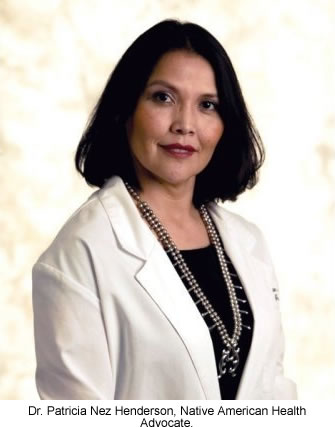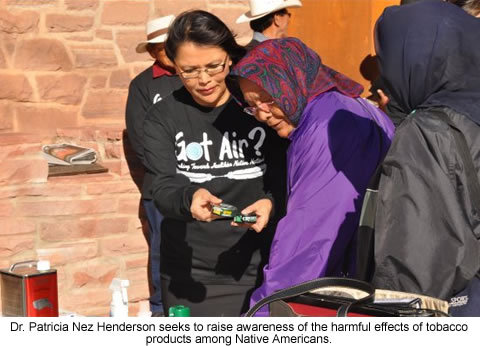 |
Canku Ota
|
 |
|
(Many Paths)
|
||
|
An Online Newsletter
Celebrating Native America
|
||
|
December 1, 2010 - Volume
8 Number 12
|
||
|
|
||
|
Dr. Patricia Nez Henderson, Native American Health Advocate
|
||
|
by Dominique Fenton
- The Huffington Post
|
||
|
Every
day on HuffPost, we're highlighting one 'Greatest Person' -- an
exceptional individual who is confronting the country's economic
and political crises with creativity, generosity and passion. Today
we feature Dr. Patricia Nez Henderson, a member of the Dine' (Navajo)
tribe. She is Vice President of the Black Hills Center for American
Indian Health, an Native American nonprofit based in Rapid City,
S.D., and is the first Native American woman to graduate from the
Yale School of Medicine. For the past decade Dr. Nez Henderson has
assisted tribal communities across the nation in enacting comprehensive
tobacco control and prevention programs. Her tireless efforts to
change the way Native Americans see and use tobacco, and her work
in advancing the health of Native communities across this country,
is something we all can learn from and be inspired by.
Dr. Patricia Nez Henderson, Native American Health Advocate.
HP:
Describe your education before college. HP:
When were you first interested in medicine?
HP:
What did you do in that year off? |
|
|
||
|
|
||
| Canku Ota is a free Newsletter celebrating Native America, its traditions and accomplishments . We do not provide subscriber or visitor names to anyone. Some articles presented in Canku Ota may contain copyright material. We have received appropriate permissions for republishing any articles. Material appearing here is distributed without profit or monetary gain to those who have expressed an interest. This is in accordance with Title 17 U.S.C. Section 107. | ||
|
Canku Ota is a copyright ©
2000, 2001, 2002, 2003, 2004, 2005, 2006, 2007, 2008, 2009, 2010
of Vicki Barry and Paul Barry.
|
||
 |
 |
|
|
The "Canku
Ota - A Newsletter Celebrating Native America" web site and
its design is the
|
||
|
Copyright ©
1999, 2000, 2001, 2002, 2003, 2004, 2005,
2006, 2007, 2008, 2009, 2010
of Paul C. Barry.
|
||
|
All Rights Reserved.
|
||
 Huffington
Post: Part of what makes you so inspiring today is where you come
from and the path you've taken to get here. Tell us about growing
up on a Navajo reservation.
Huffington
Post: Part of what makes you so inspiring today is where you come
from and the path you've taken to get here. Tell us about growing
up on a Navajo reservation.  HP:
Going to college can be challenging for anyone leaving home for
the first time. Describe the experience of leaving your reservation
to go to the University of Arizona. What obstacles did you face
during your time there?
HP:
Going to college can be challenging for anyone leaving home for
the first time. Describe the experience of leaving your reservation
to go to the University of Arizona. What obstacles did you face
during your time there?